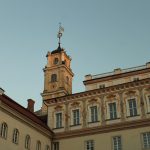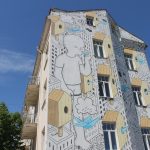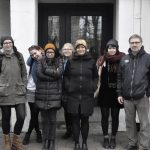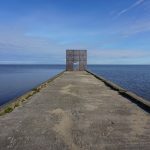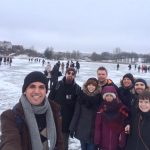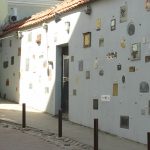Emily Dundas Oke has turned the document holder that the TRU study abroad office gave her into a mini studio—it holds drawing pencils, watercolours, scissors, glue and collage materials.
She’s always picking up free magazines and newspapers to use for collage. Lately the print materials include Lithuanian.
Dundas Oke is currently studying at two institutions in Vilnius, Lithuania—Vilnius University and the Vilnius Academy of Arts and she’s majoring in philosophy and minoring in visual arts.
She explains her affection for TRU and its unique size—big enough to enable fantastic opportunities in research, study abroad, co-op, exhibitions and community, but small enough to develop amazing rapport with wonderful professors.
Lately she’s been developing new relationships and community connections in the baroque beauty of the Baltic.
Q & A with Emily Dundas Oke
What has been great about study abroad?
The combination of an amazing place in a wonderful multi-layered context. I am a student of two institutions in a city full of art, cafés, bars, international people and interesting locals.
What surprised you about this experience?
Lithuania has been predominantly one big surprise. I intentionally knew very little about it before arriving. A major surprise is the amount of cultural events in the city. And I did not expect to meet so many international students—all of my courses are filled with students from across Europe.
Have there been any challenges that you’ve had to overcome?
Certainly. Meeting and becoming friends with locals has not been as easy as I expected, given that I live and study with other international students. That being said, Lithuanians are extremely helpful and slowly but surely I am getting there!
You’ve spent two summers working at the Kamloops Art Gallery?
I am fortunate to have worked at the Kamloops Art Gallery as both an art instructor and an installation assistant. Through the gallery, not only do I get to work with committed and supportive staff, but I have also been able to develop teaching skills, my research capacity, and understanding of arts organization and administration.
Any cool projects you’ve got to work on over there?
I have exhibited twice thus far and in unique contexts. The Vilnius Art Academy has a campus in Klaipeda and they organized a two-week participatory art workshop with two professors from Liepzig University. The workshop, titled SOURCE, was especially interesting since we were working with family archives to develop new photographs, text and an exhibition.
Also, in Vilnius, one of my courses is titled “Interactive Team Project.” Together, 18 artists from somewhere around a dozen countries worked collaboratively in an alternative space to realise an exhibition. We just had our opening last week. The opportunity to work collaboratively is rare, and to do so with so many unique artists from different backgrounds was both a challenge and a fun venture.
What are the major differences between the two institutions in Vilnius and TRU?
Course structure and approach. My lectures only meet once a week for an hour and a half. Although I am not doing any studio courses, it seems as the the visual arts students have much more freedom in their assignments. Whereas at TRU, for all my courses (both philosophy and visual arts) we have assignments due throughout the term, here, the assignments are due at the end of the semester. In addition, each visual art student has a faculty advisor throughout their whole degree with whom they work independently.
What is your top choice as a dining destination in the city?
The Alaus Biblioteka, which literally translates to Beer Library is my favorite place for a drink. They have a chart that looks like the Periodical Table of all the possible beers to try. The servers are quirky and I think know everything there is to know about beer.
What inspires you the most lately?
The spaces. It is impossible not to get lost in Vilnius Old town, as the streets are never straight and there is no grid. This spatial disorientation is still interesting to me after three months. That, and the history of spaces and places through political change.
My artwork and research in Canada before arriving to Lithuania dealt with space and identity through territories which are recognized through various levels of culture, legislation and the recognition of identity in spaces which are hard to define and which continually go through change.
Lithuania has a complex past which includes occupations of Nazi and Soviet Regimes as well as a strong history of the Great Duchy of Lithuania. Currently I am interested in how artists identify coming from and shaping this space.
What advice do you have for first year arts students?
Don’t take yourself too seriously. Get busy doing what is fun and make things happen for you and others. Just get moving and don’t be too hard on yourself. Participate in the community. Ask questions as you never know where they will lead. Have fun. Learn about art in as many ways as you can: go to galleries, volunteer, work, make and read, read, read.
Anything else you want to add about Vilnius?
It is an amazing place to live. Perhaps not well known to Canadians, but it is a burgeoning culture that is full of diverse and unique experiences. I picked it out of intuition, and am still more than thrilled to be here. It is affordable, accessible, and a wonderful place to be, especially for those interested in arts and on a budget.
You can check out Dundas Oke’s blog for more of a glimpse into her experience abroad and her interests in reading and art.
- Vilnius university in Lithuania
- Vilnius
- SOURCE workshop students
- Nida, Lithuania
- Students in Trakai, Lithuania
- Vilnius

